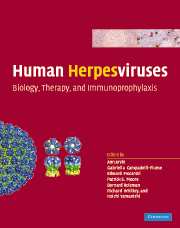Book contents
- Frontmatter
- Contents
- List of contributors
- Preface
- Part I Introduction: definition and classification of the human herpesviruses
- Part II Basic virology and viral gene effects on host cell functions: alphaherpesviruses
- Part II Basic virology and viral gene effects on host cell functions: betaherpesviruses
- Part II Basic virology and viral gene effects on host cell functions: gammaherpesviruses
- Part III Pathogenesis, clinical disease, host response, and epidemiology: HSV-1 and HSV-2
- Part III Pathogenesis, clinical disease, host response, and epidemiology: VZU
- Part III Pathogenesis, clinical disease, host response, and epidemiology: HCMV
- Part III Pathogenesis, clinical disease, host response, and epidemiology: HHV- 6A, 6B, and 7
- Part III Pathogenesis, clinical disease, host response, and epidemiology: gammaherpesviruses
- 50 Clinical and pathological aspects of EBV And KSHV infection
- 51 EBV: Immunobiology and host response
- 52 Immunobiology and host response to KSHV infection
- 53 The epidemiology of EBV and its association with malignant disease
- 54 The epidemiology of KSHV and its association with malignant disease
- 55 EBV-induced oncogenesis
- 56 KSHV-induced oncogenesis
- Part IV Non-human primate herpesviruses
- Part V Subversion of adaptive immunity
- Part VI Antiviral therapy
- Part VII Vaccines and immunothgerapy
- Part VIII Herpes as therapeutic agents
- Index
- Plate section
- References
51 - EBV: Immunobiology and host response
from Part III - Pathogenesis, clinical disease, host response, and epidemiology: gammaherpesviruses
Published online by Cambridge University Press: 24 December 2009
- Frontmatter
- Contents
- List of contributors
- Preface
- Part I Introduction: definition and classification of the human herpesviruses
- Part II Basic virology and viral gene effects on host cell functions: alphaherpesviruses
- Part II Basic virology and viral gene effects on host cell functions: betaherpesviruses
- Part II Basic virology and viral gene effects on host cell functions: gammaherpesviruses
- Part III Pathogenesis, clinical disease, host response, and epidemiology: HSV-1 and HSV-2
- Part III Pathogenesis, clinical disease, host response, and epidemiology: VZU
- Part III Pathogenesis, clinical disease, host response, and epidemiology: HCMV
- Part III Pathogenesis, clinical disease, host response, and epidemiology: HHV- 6A, 6B, and 7
- Part III Pathogenesis, clinical disease, host response, and epidemiology: gammaherpesviruses
- 50 Clinical and pathological aspects of EBV And KSHV infection
- 51 EBV: Immunobiology and host response
- 52 Immunobiology and host response to KSHV infection
- 53 The epidemiology of EBV and its association with malignant disease
- 54 The epidemiology of KSHV and its association with malignant disease
- 55 EBV-induced oncogenesis
- 56 KSHV-induced oncogenesis
- Part IV Non-human primate herpesviruses
- Part V Subversion of adaptive immunity
- Part VI Antiviral therapy
- Part VII Vaccines and immunothgerapy
- Part VIII Herpes as therapeutic agents
- Index
- Plate section
- References
Summary
Introduction
The biology and immunology of Epstein–Barr virus (EBV) has continued to fascinate researchers because the lessons learnt provide a platform for understanding the interplay between the biology of this ubiquitous infection, the immune system seeking to restrict its spread and the emergence of a variety of malignancies. As with other gamma herpes viruses, EBV encodes a large set of lytic cycle genes together with a number of latent genes which are associated with expansion of the latent EBV pool in B-lymphocytes. Current evidence suggests that the virus gains entry into the body by infection of B-lymphocytes in the oral cavity via an interaction between the major viral glycoprotein gp340 and the complement receptor CR2 which is expressed on B-cells, although a role for CR2-expressing or non-expressing epithelial and/or T-cells cannot be totally discounted. In either case, evidence suggests that the earliest detectable event following primary infection is the expression of lytic cycle proteins resulting in the release of infectious virus into the oral cavity followed by a generalized seeding of latently infected B-lymphocytes throughout the body. This primary infection results in symptoms of acute infectious mononucleosis (IM) in about 50% of adolescents and is coincident with a marked lymphocytosis (dominated by EBV-specific cytotoxic T-cells) and the appearance of an IgM response to a variety of EBV proteins, most notably the viral capsid antigen, VCA.
- Type
- Chapter
- Information
- Human HerpesvirusesBiology, Therapy, and Immunoprophylaxis, pp. 904 - 914Publisher: Cambridge University PressPrint publication year: 2007
References
- 10
- Cited by

